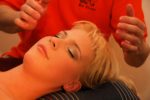
Shiatsu
 In Japan, the ancient practice of shiatsu is fully integrated into the healthcare system. Elsewhere in the world, shiatsu therapy has become popular and the UK is no exception.
In Japan, the ancient practice of shiatsu is fully integrated into the healthcare system. Elsewhere in the world, shiatsu therapy has become popular and the UK is no exception.
A physical therapy in which pressure is applied to certain points (acupoints) in the body, shiatsu originated in Japan and translates as “finger pressure”. Elbow pressure, stretching, massage and other manual techniques may also be involved.
Shiatsu aims to support and strengthen the body’s ability to balance and heal itself by focusing on the whole person; physical, psychological, emotional and spiritual elements are all thought to be interconnected.
How does it work?
Shiatsu is based on the belief that health is maintained by the smooth flow of life energy (Qi) through pathways in the body, and that illness is caused by imbalances in the natural flow.
Each acupoint is believed to affect what is referred to as Qi (pronounced ‘key’) or chi on channels that run throughout the body,” explains Lisa Esmonde, who has been a practitioner for 12 years. “Each channel is connected to a particular organ, tissue or system. All of these points (and there are many) can affect the body when they are stimulated. This is done through pressure from the shiatsu therapist and can restore the normal movement of life energy.”
Is it suitable for people with arthritis?
Shiatsu is not a generic treatment; there are lots of different styles and practitioners should offer a bespoke treatment depending on a patient’s particular issues. It is often assumed that treatments take place with the individual lying on the floor or a futon, but the reality is that the person can sit on a chair or even stand to receive Shiatsu.
“Shiatsu is a great way of tackling inflammation as it focuses on circulation and movement, easing muscles and joints and reliving stiffness and pain,” explains Adam Hellinger, vice chair of the Shiatsu Society (UK). “Inflammation is the body’s immune response. Shiatsu promotes circulation of blood and increases functioning of the lymphatic system, which can help reduce inflammation. Inflamed joints can also impinge on the nerves and shiatsu can release this and therefore reduce pain.”
Receiving shiatsu relaxes and energises the body, promoting sleep and bringing a sense of well-being.
What to expect in an appointment
A shiatsu practitioner should start by recording current and previous health issues, symptoms and treatments and lifestyle factors such as diet, exercise and sleep habits. Objectives of the treatment are then created and discussed. The session takes place through clothing and lasts for around one hour, which includes the consultation.
“Gentle pressure is applied to the acupoints mentioned or anywhere the practitioner or receiver thinks will be appropriate,” outlines Adam. “Ideally book a few sessions a week or so apart to gain the most benefit.”
Some practitioners will treat the client in the comfort of their own home. Others work from dedicated clinics, shared clinics, or a room in their own house.
Unfortunately, shiatsu is not regulated in the UK so anyone can call themselves a practitioner. To ensure you see someone qualified, they need to be a member of a professional association. The Shiatsu Society (UK) has the largest membership in the UK and practitioners on its register have met a high standard of training, have insurance and undergo continuing professional development.
“Every person with arthritis has their own version of the condition,” Adam says. “Shiatsu is gentle and tailor made for each individual’s specific needs. It is not a cure for arthritis but can help reduce some symptoms and allow people to live with their arthritis more comfortably.”
Further information
- The Shiatsu Society (UK), visit shiatsusociety.org or tel 01788 547900
 True story: Sarah Smart, aged 35 years, Kent
True story: Sarah Smart, aged 35 years, Kent
“Back, shoulder and hip pain have affected my personal and working life for a number of years. A colleague recommended a local osteopath, who did successfully alleviate the pain but only for a short time so I found myself returning every four weeks for my body to get “put back into place”.
“Five months ago I found shiatsu and it has made all the difference. Each session lasts for one hour and is nothing like a massage. I remain fully clothed, lying on my back to begin with, and the room is extremely warm as my body temperature drops rapidly during the session.
“The practitioner spends time on each pressure point, starting from my head, down to my feet. He asks me to turn over a few times during the session in order to work on the pressure points on the front of the body. Sometimes he manipulates my arms and legs in very gentle circles.
“Unlike when I had osteopathy, the pain does not return like it used to so I book in for a session every eight weeks, or more often if I feel my body needs it. My stress levels have improved too and I feel an overall sense of calm and wellbeing.
“My practitioner is calm and collected, which instantly puts me at ease. We always run through any problems before the treatments starts. He is quiet during the session and once we are finished will address any areas of concern.
“I would highly recommend people with pain and/or stress try out Shiatzu as it is the only treatment I have found that helps physically AND mentally.”
Fancy a trip? Click here for some fabulous shiatsu retreats.
